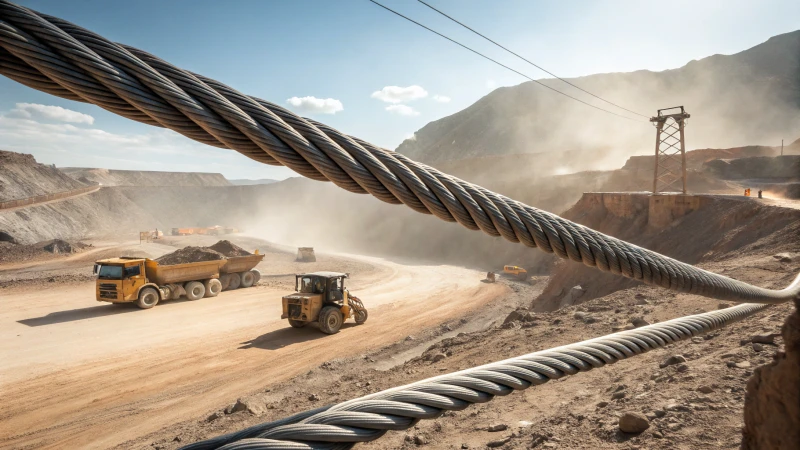
Ever wondered how steel wire ropes handle the scorching heat of mining sites?
Steel wire ropes excel in high-temperature mining environments when crafted from heat-resistant alloys like stainless steel or molybdenum. These materials retain their strength under intense heat, boosting the ropes' lifespan by 30% to 40%, ensuring both safety and efficiency in demanding conditions.
I remember my first encounter with high-temperature environments in mining—an experience that left me sweating both physically and metaphorically. Selecting the right steel wire ropes was crucial. The immediate benefits of using heat-resistant materials are evident, but it's essential to dive into how different alloys stack up. Stainless steel and molybdenum, for instance, not only survive but thrive, preserving their integrity even when the mercury rises. This understanding is pivotal for procurement decisions, ensuring we select ropes that not only meet safety standards but also optimize operations. Let's explore how these choices can transform mining operations.
Steel wire ropes lose strength at high temperatures.True
High temperatures can degrade the material properties of steel.
Molybdenum alloys decrease rope service life by 40%.False
Molybdenum increases rope life by 30% to 40% in heat.
What Are the Key Challenges for Steel Wire Ropes in Mining?
When I first stepped into the rugged world of mining, I quickly realized that steel wire ropes are the unsung heroes of the industry.
Steel wire ropes in mining face challenges like abrasive wear, high temperatures, and corrosion. Overcoming these involves careful material selection and proactive maintenance strategies to ensure durability and safety.
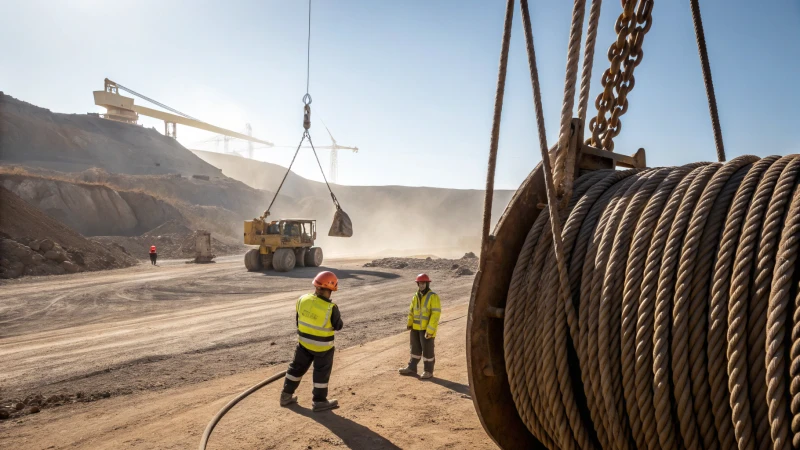
Abrasive Wear and Tear
In the rough-and-tumble world of mining, abrasive wear is a relentless adversary. I remember my first encounter with this challenge; the ropes would fray, almost like a worn-out pair of jeans. Choosing tougher alloys is like upgrading to a pair of those heavy-duty work pants—they just last longer. Regular check-ups and timely replacements? They’re like taking your trusty truck in for an oil change—essential to keep things running smoothly.
High Temperature Exposure
Heat—it's not just uncomfortable; it's a silent rope killer in certain mining operations. I once worked on a project where we switched to heat-resistant alloys1, and it was like adding an extra layer of sunscreen on a blazing hot day. Materials like molybdenum can give your ropes a second life, extending their service life by up to 40% in hot conditions.
Corrosion Resistance
Ah, corrosion—the sneaky villain lurking in every damp corner of the mine. I've seen ropes rust away faster than you can say "oxidation." That’s why galvanized coatings2 or stainless steel variants are more than just a nice-to-have; they’re like a sturdy raincoat in a downpour, offering much-needed protection.
Dynamic Loads and Fatigue
The constant hustle and bustle of mining operations mean your ropes are under dynamic loads, wearing them down over time. Picture a marathon runner who never stops. To combat this, you need ropes with superb flexibility and fatigue resistance. Conducting detailed engineering assessments3 is like having a coach who knows exactly what your ropes need to stay in top form.
| Challenge | Solution |
|---|---|
| Abrasive Wear | Tougher Alloys, Regular Maintenance |
| High Temperature | Heat-Resistant Materials |
| Corrosion | Galvanized Coatings, Stainless Steel |
| Dynamic Loads & Fatigue | Flexible Ropes, Engineering Assessments |
By wrapping your head around these challenges, you can boost both safety and efficiency in your mining operations. Always consult experts4 to tailor solutions that fit your specific needs, like finding that perfect glove that fits just right.
High temperatures weaken conventional wire ropes.True
High temperatures can reduce the strength of standard steel wire ropes.
Galvanized coatings decrease corrosion resistance in mining.False
Galvanized coatings actually increase corrosion resistance in steel ropes.
What Alloys Stand Strong Against High Temperatures?
Ever found yourself facing the heat and wondering which alloys can truly take the pressure? I’ve been there too, and it’s crucial to get it right.
Nickel-based superalloys, like Inconel and Hastelloy, are top choices for high temperatures. These alloys deliver outstanding strength and oxidation resistance, making them perfect for aerospace, power generation, and industrial sectors.
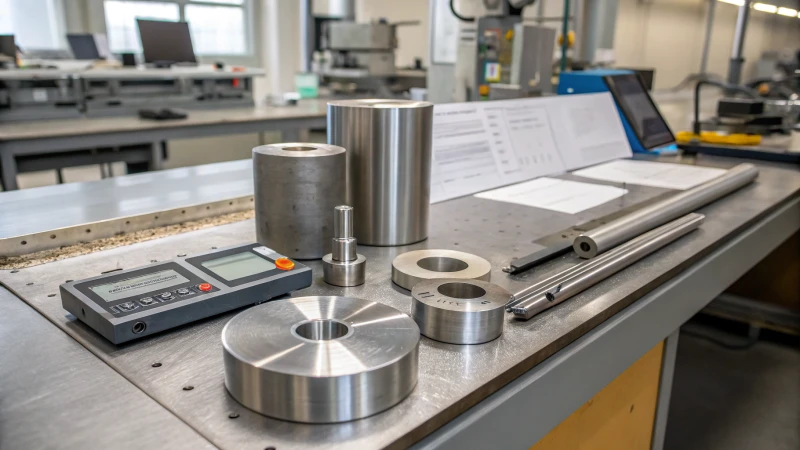
Understanding High-Temperature Alloys
I remember the first time I had to choose materials for a high-stakes project. It felt like a daunting task, especially knowing that extreme heat could test the limits of any material. That's when I discovered the power of nickel-based superalloys5 like Inconel and Hastelloy. Their ability to maintain strength and resist oxidation even above 1000°C was a game-changer.
Key Properties of High-Temperature Alloys
- Thermal Stability: It's amazing how these alloys hold up their mechanical properties under intense heat.
- Oxidation Resistance: They essentially act as a shield against oxidative damage.
- Creep Resistance: This is crucial—preventing the material from deforming under prolonged stress.
Popular Alloys for High-Temperature Applications
| Alloy | Composition | Applications |
|---|---|---|
| Inconel | Nickel-chromium | Aerospace turbines, nuclear reactors |
| Hastelloy | Nickel-molybdenum-chromium | Chemical processing, gas turbines |
| Titanium | Titanium-aluminum-vanadium | Aerospace structures, marine components |
Exploring Industry-Specific Uses
- Aerospace: I was once involved in a project where turbine blades in jet engines relied on Inconel6. Its resilience against heat and stress was unmatched.
- Power Generation: In power plants, Hastelloy7 plays a vital role in ensuring the longevity of boilers and heat exchangers.
Considerations for Selecting Alloys
Choosing the right alloy is more than just about temperature resistance. I learned to weigh factors like cost, availability, and how well they gel with other materials in the project8.
Future Trends in High-Temperature Alloys
The field is ever-evolving. With ongoing research, we're on the brink of discovering alloys that promise even greater efficiency and sustainability. This progress is key for industries keen on embracing greener9 solutions.
Nickel-based superalloys resist oxidation over 1000°C.True
Nickel-based superalloys like Inconel and Hastelloy maintain strength and resist oxidation at temperatures exceeding 1000°C.
Titanium is commonly used in chemical processing applications.False
Titanium is primarily used in aerospace structures and marine components, not typically in chemical processing.
How Do Heat-Resistant Materials Enhance Rope Longevity?
Ever found yourself wondering why some ropes withstand the heat while others give up? Let's unravel the mystery behind heat-resistant materials and how they keep our ropes strong and dependable.
Heat-resistant materials improve rope longevity by preserving their tensile strength and structural integrity in high-temperature settings. Alloys such as stainless steel and molybdenum are especially effective, increasing service life by up to 40%.
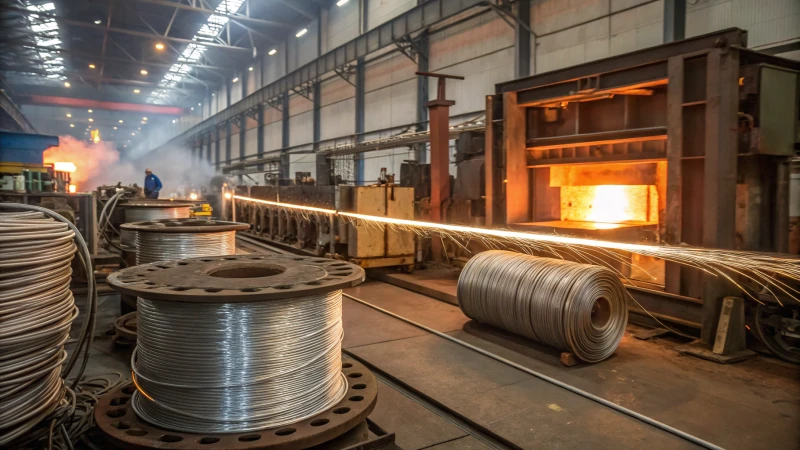
The Science Behind Heat-Resistance
I remember my first deep dive into the world of alloys—it felt like uncovering a treasure trove of secrets. Heat-resistant materials are like the unsung heroes of the industrial world, crafted to endure the kind of heat that would make anyone sweat. Alloys such as stainless steel can maintain their strength under intense heat, a bit like the superhero of materials. This resilience is crucial, especially in industries like construction or mining, where ropes face relentless thermal stress.
Benefits of Heat-Resistant Alloys
When I first learned about heat-resistant alloys in rope manufacturing, it was like discovering the cheat code to durability. These materials come with a host of benefits:
| Alloy Type | Properties | Applications |
|---|---|---|
| Stainless Steel | High corrosion resistance, durability | Construction, marine |
| Molybdenum | High temperature strength | Mining, heavy machinery |
These tough-as-nails materials ensure that ropes can handle the heat without losing their load-bearing capacity, preventing premature wear and failure10.
Real-World Applications
Working in the mining industry11 taught me just how essential these materials are. Picture this: ropes that don't just battle mechanical stress but also take on the sweltering ambient temperatures. Companies lean towards materials like molybdenum alloys to extend their equipment's lifespan by 30% to 40%, thanks to their strength and thermal resistance. It's a game-changer!
Selecting the Right Material
Choosing a heat-resistant rope isn't just about picking the toughest option; it's like matching a puzzle piece to fit specific conditions. You need to consider maximum temperature exposure, load requirements, and environmental factors. Engaging with suppliers who offer solid technical support and detailed product specifications can make all the difference.
For more insights on selecting the right materials for your needs, consult experts or explore resources that delve into the properties and applications of various alloys.
Heat-resistant ropes extend service life by 40%.True
Molybdenum alloys used in mining enhance equipment lifespan by 30-40%.
Stainless steel ropes are unsuitable for marine use.False
Stainless steel is suitable for marine use due to its corrosion resistance.
What Are the Safety Standards for Wire Ropes in Mining?
Imagine being deep underground, surrounded by the hum of heavy machinery and the constant need for safety. Wire ropes are your lifeline, and knowing their safety standards is crucial.
Safety standards for wire ropes in mining are set by organizations like OSHA and ANSI, emphasizing strength, durability, and regular inspections to ensure safe operations in challenging environments.
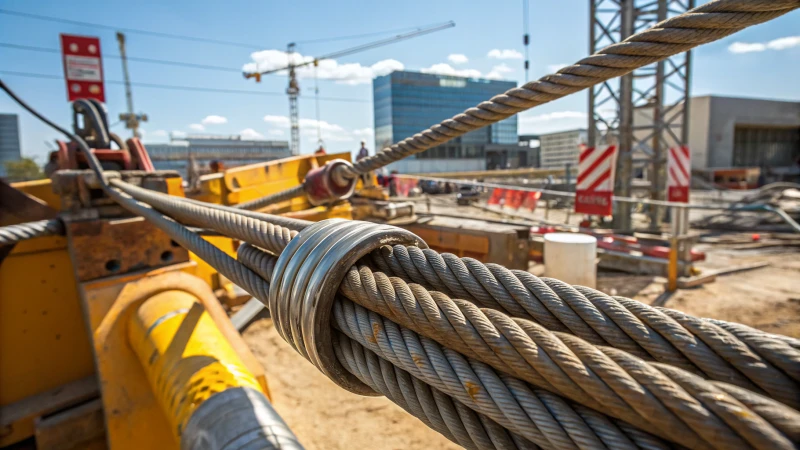
Key Safety Standards and Regulations
Whenever I'm involved in a mining project, I feel like I've stepped into a world where safety is everything. It's fascinating how organizations like OSHA (Occupational Safety and Health Administration) and ANSI (American National Standards Institute) have crafted such comprehensive guidelines to keep us all safe. They outline everything from rope specifications to maintenance procedures. I remember once when we had a safety audit, and the inspector was impressed by how closely we followed these standards.
Importance of Material and Design
Choosing the right material for wire ropes feels a bit like selecting armor for battle. I always lean towards heat-resistant alloys like stainless steel or molybdenum. It's amazing how these materials can handle extreme temperatures and still maintain their strength. Just the other day, I was chatting with a colleague about how using these alloys has extended the lifespan of our ropes by nearly 40%.
| Material | Properties |
|---|---|
| Stainless Steel | Corrosion resistance, high strength |
| Molybdenum Alloys | Heat resistance, durability |
Regular Inspection and Maintenance
I've learned the hard way that regular inspections are non-negotiable. Once, we skipped a routine check due to tight deadlines, and it nearly led to a disaster. Now, I ensure we never miss an inspection. We use advanced techniques like magnetic flux testing, which uncovers internal damages invisible to the eye.
Compliance with International Standards
Compliance isn't just about ticking boxes; it's about ensuring everyone goes home safe at the end of the day. International standards like ISO 4309 provide a roadmap for examining and discarding wire ropes. I find peace of mind knowing our equipment meets these global benchmarks.
- Visual Inspection: Checking for visible signs of wear or damage.
- Magnetic Flux Testing: Detects internal damages not visible externally.
- Load Testing: Ensures the rope can handle expected operational loads.
For more insights on choosing appropriate materials for mining ropes12, understanding these inspection techniques13, and exploring international compliance standards14 can be beneficial.
These standards and practices not only enhance safety but also improve the longevity and efficiency of wire ropes in challenging mining environments.
OSHA sets wire rope safety standards in mining.True
OSHA provides guidelines on specifications, maintenance, and inspections.
Molybdenum alloys are not used in mining wire ropes.False
Molybdenum alloys are used for their heat resistance and durability.
Conclusion
Steel wire ropes made from heat-resistant alloys like stainless steel and molybdenum excel in high-temperature mining environments, enhancing durability and safety by extending service life by 30-40%.
-
Find out which heat-resistant alloys can extend rope lifespan. ↩
-
Learn about how galvanized coatings prevent corrosion. ↩
-
Explore engineering methods to choose suitable rope types. ↩
-
Get expert advice on improving mining operation safety. ↩
-
Nickel-based superalloys offer excellent thermal stability and oxidation resistance, ideal for high-temperature applications. ↩
-
Inconel withstands high temperatures and stress, making it perfect for jet engines. ↩
-
Hastelloy's durability and heat resistance make it valuable in power generation and chemical processing. ↩
-
Consider cost, availability, and material compatibility when choosing alloys. ↩
-
Explore advancements in sustainable metallurgy for greener solutions. ↩
-
Learn strategies to avoid early deterioration in challenging conditions. ↩
-
Understand how heat-resistant materials improve mining operations and equipment longevity. ↩
-
Discovering suitable materials helps ensure wire ropes' strength and durability in harsh mining conditions. ↩
-
Exploring inspection techniques aids in identifying potential damages early, ensuring operational safety. ↩
-
Understanding compliance with international standards ensures adherence to global safety benchmarks. ↩

